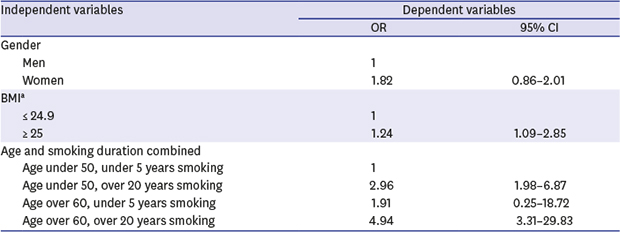2. Lopez AD, Mathers CD, Ezzati M, Jamison DT, Murray CJ. Global Burden of Disease and Risk Factors. Washington, D.C.: The World Bank;2006.
3. Pierce JP, Messer K, White MM, Cowling DW, Thomas DP. Prevalence of heavy smoking in California and the United States, 1965–2007. JAMA. 2011; 305(11):1106–1112.


4. Soriano JB, Ancochea J, Miravitlles M, García-Río F, Duran-Tauleria E, Muñoz L, et al. Recent trends in COPD prevalence in Spain: a repeated cross-sectional survey 1997–2007. Eur Respir J. 2010; 36(4):758–765.


5. Halldin CN, Doney BC, Hnizdo E. Changes in prevalence of chronic obstructive pulmonary disease and asthma in the US population and associated risk factors. Chron Respir Dis. 2015; 12(1):47–60.


6. Pelkonen MK, Notkola IL, Laatikainen TK, Koskela HO. Twenty-five year trends in prevalence of chronic bronchitis and the trends in relation to smoking. Respir Med. 2014; 108(11):1633–1640.


7. Kim C, Yoo KH, Rhee CK, Yoon HK, Kim YS, Lee SW, et al. Health care use and economic burden of patients with diagnosed chronic obstructive pulmonary disease in Korea. Int J Tuberc Lung Dis. 2014; 18(6):737–743.


8. Kim J, Rhee CK, Yoo KH, Kim YS, Lee SW, Park YB, et al. The health care burden of high grade chronic obstructive pulmonary disease in Korea: analysis of the Korean Health Insurance Review and Assessment Service data. Int J Chron Obstruct Pulmon Dis. 2013; 8:561–568.


9. Feenstra TL, van Genugten ML, Hoogenveen RT, Wouters EF, Rutten-van Mölken MP. The impact of aging and smoking on the future burden of chronic obstructive pulmonary disease: a model analysis in the Netherlands. Am J Respir Crit Care Med. 2001; 164(4):590–596.
10. American Thoracic Society. Standards for the diagnosis and care of patients with chronic obstructive pulmonary disease. Am J Respir Crit Care Med. 1995; 152(5 Pt 2):S77–S121.
11. Siafakas NM, Vermeire P, Pride NB, Paoletti P, Gibson J, Howard P, et al. Optimal assessment and management of chronic obstructive pulmonary disease (COPD). Eur Respir J. 1995; 8(8):1398–1420.


12. Van Remoortel H, Hornikx M, Langer D, Burtin C, Everaerts S, Verhamme P, et al. Risk factors and comorbidities in the preclinical stages of chronic obstructive pulmonary disease. Am J Respir Crit Care Med. 2014; 189(1):30–38.


13. Jha P, Peto R. Global effects of smoking, of quitting, and of taxing tobacco. N Engl J Med. 2014; 370(1):60–68.


14. U.S. Department of Health and Human Services. The Health Benefits of Smoking Cessation. A Report on the Surgeon General. Washington, D.C.: United States Government Publishing Office;1990.
15. Barendregt JJ, Bonneux L, van der Maas PJ. The health care costs of smoking. N Engl J Med. 1997; 337(15):1052–1057.


16. World Health Organization. International Statistical Classification of Diseases and Related Health Problems. 10th ed. Geneva: World Health Organization;2010.
17. Lundbäck B, Lindberg A, Lindström M, Rönmark E, Jonsson AC, Jönsson E, et al. Not 15 but 50% of smokers develop COPD?--report from the obstructive lung disease in northern Sweden studies. Respir Med. 2003; 97(2):115–122.

18. Celli BR, MacNee W. Committee members. Eur Respir J. 2004; 23:932–946.

19. Boyer L, Chouaïd C, Bastuji-Garin S, Marcos E, Margarit L, Le Corvoisier P, et al. Aging-related systemic manifestations in COPD patients and cigarette smokers. PLoS One. 2015; 10(3):e0121539.

20. World Health Organization. Draft Action Plan for the Prevention and Control of Non-communicable Diseases 2013–2020. Geneva: World Health Assembly, World Health Organization;2013.
21. Sobradillo V, Miravitlles M, Jiménez CA, Gabriel R, Viejo JL, Masa JF, et al. Epidemiological study of chronic obstructive pulmonary disease in Spain (IBERPOC): prevalence of chronic respiratory symptoms and airflow limitation. Arch Bronconeumol. 1999; 35(4):159–166.

22. Mannino DM, Gagnon RC, Petty TL, Lydick E. Obstructive lung disease and low lung function in adults in the United States: data from the National Health and Nutrition Examination Survey, 1988–1994. Arch Intern Med. 2000; 160(11):1683–1689.

23. World Health Organization. Global Surveillance, Prevention and Control of Chronic Respiratory Diseases: a Comprehensive Approach. Geneva: World Health Organization;2007.
24. Anthonisen NR. The British hypothesis revisited. Eur Respir J. 2004; 23(5):657–658.


25. Vestbo J, Prescott E. Update on the “Dutch hypothesis” for chronic respiratory disease. Thorax. 1998; 53:Suppl 2. S15–S19.

26. Fletcher C, Peto R, Tinker CM, Speizer FE. The Natural History of Chronic Bronchitis and Emphysema. Oxford: Oxford University Press;1976.
27. Jemal A, Ward E, Hao Y, Thun M. Trends in the leading causes of death in the United States, 1970–2002. JAMA. 2005; 294(10):1255–1259.


28. Mannino DM, Homa DM, Akinbami LJ, Ford ES, Redd SC. Chronic obstructive pulmonary disease surveillance--United States, 1971–2000. Respir Care. 2002; 47(10):1184–1199.








 PDF
PDF Citation
Citation Print
Print




 XML Download
XML Download